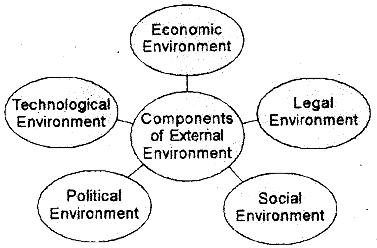Kerala Plus Two Business Studies Notes Chapter 3 Business Environment
Meaning of Business Environment
The term ‘business environment’ means the sum total of all individuals, institutions and other forces that are outside the control of a business enterprise but that may affect its performance.
Features of Business Environment
- Totality of external forces: Business environment is the sum total of all the forces/ factors external to a business firm.
- Specific and general forces: Specific forces includes investors, competitors, customers, etc. who influence business firm directly while general forces includes social, political, economic, legal and technological conditions which affect a business firm indirectly.
- Interrelatedness: All the factors of a business environment are closely interrelated.
- Dynamic: Business environment is dynamic in nature which keeps on changing with the change in technology, consumers fashion and tastes etc.
- Uncertainty: Business environment is uncertain as it is difficult to predict the future environmental changes.
- Complexity: Environment is a complex phenomenon that is relatively easier to understand in parts but difficult to grasp in its totality.
- Relativity: Business environment is a relative concept since it differs from country to country and region to region.
Importance of Business Environment
- Identification of opportunities: Environment provides numerous opportunities for business success. Early identification of opportunities helps an enterprise to be the first to exploit them.
- Identification of threats: Environmental awareness help managers to identify various threats on time and serves as an early warning signal.
- Tapping useful resources: Business environment helps to know the availability of resources and making them available on time.
- Coping with rapid changes: Environmental scanning enables the firms to adapt themselves to the changes in the market.
- Assistance in planning and policy formulation: Environmental understanding and analysis is the basis for planning and policy making.
- Improving performance: Environment scanning helps an organisation in improving its performance
Dimensions of Business Environment

1) Economic Environment: Interest rates, inflation rates, changes in disposable income of people, stock market indices and the value of rupee are some of the economic factors that can affect the business enterprise.
2) Social Environment: The social environment of business includes the social forces like customs and traditions, values, social trends, literacy rate, educational levels, lifestyle, etc.
3) Technological Environment: Technological environment consists of new products, new technologies, new approaches to product, new methods and equipments, etc.
4) Political Environment: Political environment includes constitution, political parties and their ideology, types of govt., political stability, attitude towards business, etc,
5) Legal Environment: Legal environment includes various legislations passed by the central, state or local government.
Economic Environment in India
As a part of economic reforms, the Government of India announced a new industrial policy in July 1991. The broad features of this policy were as follows.
- The government reduced number of industries under compulsory licensing to six.
- The role of public sector was limited only to four industries.
- Disinvestment was carried out in case of many public sectors industrial enterprises
- Policy towards foreign capital was liberalized
- Automatic permission was granted for technology agreements with foreign component.
- Foreign Investment Promotion Board (FIPB) was set up to promote and channelize foreign investment in India.
Liberalisation
Liberalization of economy means to free it from direct control imposed by the government. Liberalisation of the Indian industry has taken place with respect to the following.
- Abolishing licensing requirement in most of the industries
- Freedom in deciding the scale of business activities
- Removal of restrictions on the movement of goods and services
- Freedom in fixing the prices of goods and services
- Reduction in tax rates
- Simplifying procedures for imports and exports
- Attract foreign capital and technology to India.
Privatisation
Privatisation means transfer of the public sector enterprises to the private sector. The role of private sector is encouraged.
This can be done in two ways.
- Disinvestment of a part of the shares held by the government in public sector units.
- Dereservatiion of areas formerly reserved for the public sector.
Globalization
Globalisation means the integration of the various economies of the world leading towards the emergence of a cohesive global economy.
Features of Globalisation:
- Free flow of goods and services across nations
- Free flow of capital across nations
- Free flow of information and technology
- Free movement of people across borders
Impact of Government Policy Changes on Business and Industry
The government policy of liberalisation, privatisation and globalisation has made a definite impact on the working of enterprises in business and industry in terms of the following.
- Competition for Indian firms has increased.
- The customer’s wider choice in purchasing better quality of goods and services.
- Rapid technological advancement has changed/ improved the production process.
- Enterprises are forced to continuously modify their operations.
- Need for Developing Human Resources arise.
- There is a shift from production oriented concept to market oriented concept.
